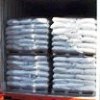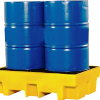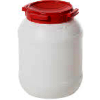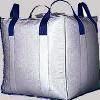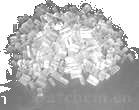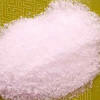Sodium Thiosulfate, Sodium Thiosulphate Anhydrous Pentahydrate Manufacturers Suppliers, India
Anmol Chemicals are manufacturers of Specialty Chemicals and Pharmaceutical Excipients, in India. Anmol Chemicals Group has manufacturing facilities spread across India, representatives in Houston Chicago USA and toll manufacturers in China. We make IP, BP, USP, Ph Eur, FCC or Food Grade, ACS, AR or Analytical Reagent Grade, LR or Laboratory Reagent Grade and Pure Grades of various chemicals. All our items are analyzed to meet the required standards.
Our manufacturing facility is FDA GMP approved and ISO-9001, ISO 14000, OHSAS 18000, ISO 22000, FSSAI HACCP certified. We are offering products manufactured as per Kosher and Halal approved method. We are pre-registered with "Reach" for export to European countries.
Sodium thiosulfate (Na2S2O3), also spelled Sodium thiosulphate, or thio sulphate is a colorless crystalline compound that is more familiar as the pentahydrate, Na2S2O3•5H2O. It is an efflorescent, monoclinic crystalline substance also called sodium hyposulfite or “hypo.”
Sodium Thiosulphate Pentahydrate or Sodium Thiosulfate or Sodium Hyposulfite Specifications:
ITC-HSN Code: 2832 30 10
CAS: 10102-17-7 (7772-98-7 Anhydrous)
Formula : Na2S2O3.5H2O
Molecular Weight: 248
Appearance: White Crystalline
Sodium Thiosulphate Commercial
| Parameters | Specifications |
| Appearance | Fine Crystalline |
| pH of 10% Aqueous Solution | 6.5 to 8 |
| Assay | 98% minimum |
| Sulphites & Sulphates | 1% max |
| Heavy Metals | Less than 5 ppm |
| Iron | Less than 10 ppm |
Sodium Thio sulfate Pure
| Parameters | Specifications |
| Appearance | White Uniform Crystals (10 mesh) |
| pH of 10% Aqueous Solution | 6.5 to 8 |
| Assay | 99% minimum |
| Sulphites & Sulphates | 0.2% max |
| Heavy Metals | Less than 5 ppm |
| Iron | Less than 10 ppm |
Sodium Thiosulfate Photographic P4 & P8 Pea Crystals
| Parameters | Specifications |
| Appearance | Cylindrical Pellets (5 mm to 10 mm for P4) & (2 mm to 5 mm for P8) |
| pH of 10% Aqueous Solution | 6.5 to 8 |
| Assay | 99.5% minimum |
| Sulphites & Sulphates | 0.2% max |
| Heavy Metals | Less than 3 ppm |
| Iron | Less than 5 ppm |
We can give both the grades Sodium Thiosulfate Pentahydrate and Anhydrous. We can give the technical grade small crystals and large crystals too.
We offer Sodium Thiosulphate BP IP, Sodium Thiosulfate USP, and Sodium Thiosulfate Extra Pure from our world class FDA approved, ISO-9001-2008, ISO-22000-2005 Certified facility.
Information on IP, BP, USP, ACS, Food Grade is provided by manufacturer on Hypo USP ACS AR BP IP Food Grade
General Information
The thiosulfate anion is tetrahedral in shape and is notionally derived by replacing one of the oxygen atoms by a sulfur atom in a sulfate anion. The S-S distance indicates a single bond, implying that the sulfur bears significant negative charge and the S-O interactions have more double bond character. The first protonation of thiosulphate occurs at sulfur.
Thiosulfate anion characteristically reacts with dilute acids to produce sulfur, sulfur dioxide and water
Na2S2O3 + 2HCl → 2NaCl + S + SO2 + H2O
This reaction is known as a clock reaction, because when the sulfur reaches a certain concentration the solution turns from colourless to a pale yellow. This reaction has been employed to generate colloidal sulfur. When the protonation is conducted at low temperatures, H2S2O3 (thiosulfuric acid) can be obtained. It is a strong acid pKa
Iodometry
In analytical chemistry, the most important use comes from the fact that the thiosulphate anion reacts stoichiometrically with iodine, reducing it to iodide as it is oxidized to tetrathionate:
2 S2O32−(aq) + I2(aq) → S4O62−(aq) + 2 I−(aq)
Due to the quantitative nature of this reaction, as well as the fact that Na2S2O3•5H2O has an excellent shelf-life, it is used as a titrant in iodometry. Na2S2O3•5H2O is also a component of iodine clock experiments.
This particular use can be set up to measure the oxygen content of water through a long series of reactions. It is also used in estimating volumetrically, the concentrations of certain compounds in solution (hydrogen peroxide, for instance), and in estimating the chlorine content in commercial bleaching powder and water.
Gold extraction
Sodium thiosulphate is one component of an alternative lixiviant to cyanide for extraction of gold. It forms a strong complex with gold (I) ions, [Au(S2O3)2]3-. The advantage of this approach is that thiosulfate is essentially non-toxic and that ore types that are refractory to gold cyanidation (e.g. carbonaceous or Carlin type ores) can be leached by thiosulphate. Some problems with this alternative process include the high consumption of thiosulfate, and the lack of a suitable recovery technique, since [Au(S2O3)2]3- does not adsorb to activated carbon, which is the standard technique used in gold cyanidation to separate the gold complex from the ore slurry.
Analytical chemistry
Sodium thiosulphate is also used in analytical chemistry. It can, when heated with a sample containing aluminum cation, produce a white precipitation:
2Al3+ + 3S2O32- + 3H2O → 3SO2 + 3S + 2Al(OH)3
Medical
It is used as an antidote to cyanide poisoning. Thiosulphate acts as a sulfur donor for the conversion for cyanide to thiocyanate (which can then be safely excreted in the urine), catalyzed by the enzyme rhodanase.
It has also been used as treatment of calciphylaxis in hem dialysis patients with end-stage renal disease.
Other uses
Sodium thiosulfate is used as a component in hand warmers and other chemical heating pads that produce heat by exothermic crystallization
of a super cooled solution.
Sodium thiosulphate is used in Bleach.
In pH testing of bleach substances.
To de-chlorinate tap water for aquariums or treat effluent from waste water treatments prior to release into rivers. The amount of Sodium thiosulphate required can
vary with the pH of the water. A range of approximately 2 to 7 parts sodium thiosulfate to neutralize one part chlorine is generally suggested. To neutralize 1 liter of
a 200 ppm chlorine solution, approximately 0.4 - 1.4 grams of sodium thiosulfate would be required.
It is used to lower chlorine levels in swimming pools and spas following super chlorination.
It is used to remove iodine stains, e.g. after the explosion of nitrogen triiodide.
Sodium thiosulphate is used in bacteriological water assessment.
It is used in the tanning of leather.
Melted sodium thiosulfate is very easy to overcool to room temperature and when crystallization is forced, the sudden temperature jump to 48.3°C can be experienced by
touch. It is used in phase change material.
Sodium thiosulfate or Sodium thiosulphate is used in paper industry.
It is used in medicine and as disinfectant. A low amount can be found in natural hot springs water, but they do have trace sodium sulfide too, which is why it can used
to treat skin problems and some bathe in it to relieve them of skin problems, rheumatism, although indirectly. It is systemically for cyanide or arsenic poisoning and
topically as an antifungal.
It is used in electroplating.
As part of patina recipes for copper alloys.
Often used in pharmaceutical preparations as an anionic surfactant to aid in dispersion.

Manufacturers
ANMOL CHEMICALS
S-8, SARIFA MANSION, 2ND PRINCIPAL SHAIKH HASAN MARG, MUMBAI 400009, INDIA
TEL: (OFF) 91-22-23726950, 23774610, 23723564. FAX: 91-22-23728264
e-mail: info@anmol.org
Copyright and Usual Disclaimer is Applicable
Exporters to USA, UAE, Europe, South Africa, Tanzania, Kenya, Egypt, Turkey, Nigeria, Uganda, Brazil, Chile, Argentina, Dubai etc.
Representatives in New York, Houston - Texas, Chicago - Illinois, Los Angeles.
Fast Selling IP BP USP ACS FCC Food Grades of Chemicals by Anmol Chemicals
Aluminum Chloride ---------- Ammonium Sulfate ----- Ammonium Persulfate
Aluminum Potassium Sulfate - Ammonium Chloride ---- Ammonium Bicarbonate
Ammonium Carbonate --------- Benzyl Alcohol ------- Boric Acid
Benzoic Acid --------------- Borax; Sodium Borate - Calcium Chloride
Calcium Hydroxide ---------- Calcium Acetate ------ Calcium Butyrate
Calcium Lactobionate ------- Calcium Levulinate --- Calcium Saccharate
Carbamide Peroxide --------- Citric Acid ---------- Calcium Phosphate
Calcium Oxide -------------- Calcium Sulfate ------ Chromic Chloride
Cupric Chloride ------------
Ferric Chloride ------------ Ferric Nitrate ------- Fumaric Acid
Gentian Violet ------------- Glacial Acetic Acid
Lactobionic Acid ----------- Magnesium Butyrate
Magnesium Oxide ------------ Magnesium Chloride --- Magnesium Sulfate
Malic Acid ----------------- Maleic Acid ---------- Manganese Chloride
Manganese Sulfate ---------- Methylene Blue ------- Oleic Acid
Octyldodecanol -------------
Propylene Carbonate -------- Potassium Acetate ---- Potassium Carbonate
Potassium Hydroxide -------- Potassium Chloride --- Potassium Phosphate
Potassium Bitartrate ------- Propylene Carbonate -- Selenious acid
Sodium Molybdate ----------- Sodium Perborate ----- Sodium Phosphate
Sodium Propionate ---------- Sodium Acetate ------- Sodium Bicarbonate
Sodium Hydroxide ----------- Sodium Chloride ------ Sodium Thiosulfate
Sodium Selenite ------------ Urea ----------------- Zinc Chloride
Other Best Selling Products
Ammonium Bromide ----------- Ammonium Phosphate --- Barium Chloride
Butylated Hydroxyanisole --- Butylated Hydroxytoluene
Calcium Nitrate Nitrite ---- Calcium Propionate --- Copper Sulfate
Ceric Ammonium Nitrate ----- Cinnamaldehyde ------- Isatoic Anhydride
Directly Compressible Calcium Carbonate ----------- Encapsulated Citric Acid
Encapsulated Fumaric Acid -- Encapsulated Sodium Bicarbonate -
Encapsulated Sorbic Acid
Potassium Bromide ---------- Potassium Iodide ----- Potassium Nitrate Nitrite
Sodium Bromate ------------- Skatole -------------- Sodium Butyrate
Sodium Nitrite & Nitrate --- Sodium Bromide ------- Sodium Diacetate
Sodium Formaldehyde Bisulfite Strontium Chloride -- Stannous Chloride
TBHQ Tertiary Butylhydroquinone







